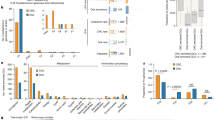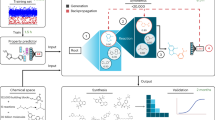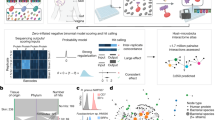Abstract
The ever-increasing incidence of antibiotic-resistant infections combined with a weak pipeline of new antibiotics has created a global public health crisis1. Accordingly, novel strategies for enhancing our antibiotic arsenal are needed. As antibiotics kill bacteria in part by inducing reactive oxygen species (ROS)2,3,4, we reasoned that targeting microbial ROS production might potentiate antibiotic activity. Here we show that ROS production can be predictably enhanced in Escherichia coli, increasing the bacteria's susceptibility to oxidative attack. We developed an ensemble approach of genome-scale, metabolic models capable of predicting ROS production in E. coli. The metabolic network was systematically perturbed and its flux distribution analyzed to identify targets predicted to increase ROS production. Targets that were predicted in silico were experimentally validated and further shown to confer increased susceptibility to oxidants. Validated targets also increased susceptibility to killing by antibiotics. This work establishes a systems-based method to tune ROS production in bacteria and demonstrates that increased microbial ROS production can potentiate killing by oxidants and antibiotics.
This is a preview of subscription content, access via your institution
Access options
Subscribe to this journal
Receive 12 print issues and online access
$209.00 per year
only $17.42 per issue
Buy this article
- Purchase on Springer Link
- Instant access to full article PDF
Prices may be subject to local taxes which are calculated during checkout




Similar content being viewed by others
References
Arias, C.A. & Murray, B.E. Antibiotic-resistant bugs in the 21st century–a clinical super-challenge. N. Engl. J. Med. 360, 439–443 (2009).
Foti, J.J., Devadoss, B., Winkler, J.A., Collins, J.J. & Walker, G.C. Oxidation of the guanine nucleotide pool underlies cell death by bactericidal antibiotics. Science 336, 315–319 (2012).
Kohanski, M.A., Dwyer, D.J., Hayete, B., Lawrence, C.A. & Collins, J.J. A common mechanism of cellular death induced by bactericidal antibiotics. Cell 130, 797–810 (2007).
Kohanski, M.A., Dwyer, D.J., Wierzbowski, J., Cottarel, G. & Collins, J.J. Mistranslation of membrane proteins and two-component system activation trigger antibiotic-mediated cell death. Cell 135, 679–690 (2008).
Carlioz, A. & Touati, D. Isolation of superoxide dismutase mutants in Escherichia coli: is superoxide dismutase necessary for aerobic life? EMBO J. 5, 623–630 (1986).
Loewen, P.C. Isolation of catalase-deficient Escherichia coli mutants and genetic mapping of katE, a locus that affects catalase activity. J. Bacteriol. 157, 622–626 (1984).
Dwyer, D.J., Kohanski, M.A., Hayete, B. & Collins, J.J. Gyrase inhibitors induce an oxidative damage cellular death pathway in Escherichia coli. Mol. Syst. Biol. 3, 91 (2007).
Hebrard, M., Viala, J.P., Meresse, S., Barras, F. & Aussel, L. Redundant hydrogen peroxide scavengers contribute to Salmonella virulence and oxidative stress resistance. J. Bacteriol. 191, 4605–4614 (2009).
Liu, C.I. et al. A cholesterol biosynthesis inhibitor blocks Staphylococcus aureus virulence. Science 319, 1391–1394 (2008).
Imlay, J.A. & Fridovich, I. Assay of metabolic superoxide production in Escherichia coli. J. Biol. Chem. 266, 6957–6965 (1991).
Korshunov, S. & Imlay, J.A. Two sources of endogenous hydrogen peroxide in Escherichia coli. Mol. Microbiol. 75, 1389–1401 (2010).
Massey, V. Activation of molecular oxygen by flavins and flavoproteins. J. Biol. Chem. 269, 22459–22462 (1994).
Messner, K.R. & Imlay, J.A. The identification of primary sites of superoxide and hydrogen peroxide formation in the aerobic respiratory chain and sulfite reductase complex of Escherichia coli. J. Biol. Chem. 274, 10119–10128 (1999).
Feist, A.M. & Palsson, B.O. The growing scope of applications of genome-scale metabolic reconstructions using Escherichia coli. Nat. Biotechnol. 26, 659–667 (2008).
Becker, S.A. & Palsson, B.O. Context-specific metabolic networks are consistent with experiments. PLoS Comput. Biol. 4, e1000082 (2008).
Covert, M.W., Knight, E.M., Reed, J.L., Herrgard, M.J. & Palsson, B.O. Integrating high-throughput and computational data elucidates bacterial networks. Nature 429, 92–96 (2004).
Feist, A.M. et al. A genome-scale metabolic reconstruction for Escherichia coli K-12 MG1655 that accounts for 1260 ORFs and thermodynamic information. Mol. Syst. Biol. 3, 121 (2007).
Messner, K.R. & Imlay, J.A. Mechanism of superoxide and hydrogen peroxide formation by fumarate reductase, succinate dehydrogenase, and aspartate oxidase. J. Biol. Chem. 277, 42563–42571 (2002).
Edwards, J.S., Ibarra, R.U. & Palsson, B.O. In silico predictions of Escherichia coli metabolic capabilities are consistent with experimental data. Nat. Biotechnol. 19, 125–130 (2001).
Imlay, J.A. Pathways of oxidative damage. Annu. Rev. Microbiol. 57, 395–418 (2003).
Winter, J., Ilbert, M., Graf, P.C., Ozcelik, D. & Jakob, U. Bleach activates a redox-regulated chaperone by oxidative protein unfolding. Cell 135, 691–701 (2008).
Taber, H.W., Mueller, J.P., Miller, P.F. & Arrow, A.S. Bacterial uptake of aminoglycoside antibiotics. Microbiol. Rev. 51, 439–457 (1987).
Jensen, P.R. & Michelsen, O. Carbon and energy metabolism of atp mutants of Escherichia coli. J. Bacteriol. 174, 7635–7641 (1992).
Boshoff, H.I. et al. The transcriptional responses of Mycobacterium tuberculosis to inhibitors of metabolism: novel insights into drug mechanisms of action. J. Biol. Chem. 279, 40174–40184 (2004).
AbuOun, M. et al. Genome scale reconstruction of a Salmonella metabolic model: comparison of similarity and differences with a commensal Escherichia coli strain. J. Biol. Chem. 284, 29480–29488 (2009).
Becker, S.A. & Palsson, B.O. Genome-scale reconstruction of the metabolic network in Staphylococcus aureus N315: an initial draft to the two-dimensional annotation. BMC Microbiol. 5, 8 (2005).
Jamshidi, N. & Palsson, B.O. Investigating the metabolic capabilities of Mycobacterium tuberculosis H37Rv using the in silico strain iNJ661 and proposing alternative drug targets. BMC Syst. Biol. 1, 26 (2007).
Schilling, C.H. & Palsson, B.O. Assessment of the metabolic capabilities of Haemophilus influenzae Rd through a genome-scale pathway analysis. J. Theor. Biol. 203, 249–283 (2000).
Henry, C.S. et al. High-throughput generation, optimization and analysis of genome-scale metabolic models. Nat. Biotechnol. 28, 977–982 (2010).
Baba, T. et al. Construction of Escherichia coli K-12 in-frame, single-gene knockout mutants: the Keio collection. Mol. Syst. Biol. 2, 2006.0008 (2006).
Belousov, V.V. et al. Genetically encoded fluorescent indicator for intracellular hydrogen peroxide. Nat. Methods 3, 281–286 (2006).
Malinouski, M., Zhou, Y., Belousov, V.V., Hatfield, D.L. & Gladyshev, V.N. Hydrogen peroxide probes directed to different cellular compartments. PLoS ONE 6, e14564 (2011).
Dukan, S. & Touati, D. Hypochlorous acid stress in Escherichia coli: resistance, DNA damage, and comparison with hydrogen peroxide stress. J. Bacteriol. 178, 6145–6150 (1996).
Yeh, P. & Kishony, R. Networks from drug-drug surfaces. Mol. Syst. Biol. 3, 85 (2007).
Hegreness, M., Shoresh, N., Damian, D., Hartl, D. & Kishony, R. Accelerated evolution of resistance in multidrug environments. Proc. Natl. Acad. Sci. USA 105, 13977–13981 (2008).
Becker, S.A. et al. Quantitative prediction of cellular metabolism with constraint-based models: the COBRA Toolbox. Nat. Protoc. 2, 727–738 (2007).
Acknowledgements
This work was supported by the National Institutes of Health Director′s Pioneer Award Program and the Howard Hughes Medical Institute.
Author information
Authors and Affiliations
Contributions
M.P.B., J.A.W. and J.J.C. designed the study, analyzed the results and wrote the manuscript. Experiments were done by M.P.B., J.A.W., C.S.S. and I.C.M.
Corresponding author
Ethics declarations
Competing interests
The authors have filed US Patent Application no. 61/583,662 covering the method described in the paper.
Supplementary information
Supplementary Text and Figures
Supplementary Methods and Supplementary Figures 1–4 (PDF 596 kb)
Supplementary Data File 1
Constants used to couple ROS generating reactions to their intended reactions within iAF1260 (XLS 9555 kb)
Supplementary Table 1
Potential ROS-generation reactions within iAF1260 (XLSX 24 kb)
Supplementary Table 2
ROS generation within iAF1260 (XLSX 9 kb)
Supplementary Table 3
Enzymes and regulators turned off due to transcriptional regulation in aerobic minimal glucose media (XLSX 31 kb)
Supplementary Table 4
ROS/BM for genetic selections that altered ROS flux (XLSX 11 kb)
Supplementary Table 5
GFP/BM measurements for deletion strains with reporter plasmids (XLSX 10 kb)
Supplementary Table 6
Relative (500nm/420nm) fluorescence ratio of mutant strains (XLSX 9 kb)
Rights and permissions
About this article
Cite this article
Brynildsen, M., Winkler, J., Spina, C. et al. Potentiating antibacterial activity by predictably enhancing endogenous microbial ROS production. Nat Biotechnol 31, 160–165 (2013). https://doi.org/10.1038/nbt.2458
Received:
Accepted:
Published:
Issue Date:
DOI: https://doi.org/10.1038/nbt.2458
This article is cited by
-
Metabolic genes on conjugative plasmids are highly prevalent in Escherichia coli and can protect against antibiotic treatment
The ISME Journal (2023)
-
ROS-induced lipid peroxidation modulates cell death outcome: mechanisms behind apoptosis, autophagy, and ferroptosis
Archives of Toxicology (2023)
-
Immobilized CeO2@C-N Heterogenous Structures with Enhanced Dual Modal Photodynamic/Photothermal Bacterial Inactivation Under NIR Laser Irradiation
Journal of Analysis and Testing (2023)
-
Comparing the toxicity of tungsten and vanadium oxide nanoparticles on Spirulina platensis
Environmental Science and Pollution Research (2023)
-
Discovery of a novel antibacterial protein CB6-C to target methicillin-resistant Staphylococcus aureus
Microbial Cell Factories (2022)



